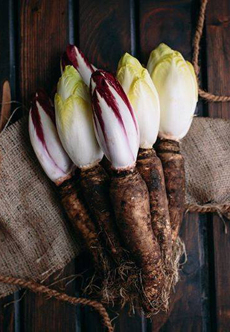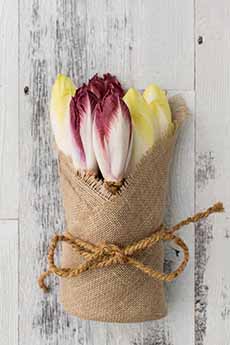Grilled Belgian Endive Recipe & The History Of Belgian Endive
|
You may have grilled romaine, but how about grilled endive? Thanks to modern farming techniques, endive is available year-round. It can be grilled, added to salads, or used as “boats” to hold finger foods at parties—the latter an easy-to-make, no-cooking dish that looks impressive. Appetizers, salads, mains, sides, soups—even for dessert, you can make a type of Tarte Tatin using endive instead of apples. Here are dozens of endive recipes from California endive growers. If you’re grilling this weekend, here’s a simple side with big flavor. Grilled endives also provide the base for a great summer salad. See the variation below. A leaf of endive has just one calorie! It’s a good source of potassium, vitamins, and minerals, high in complex fiber, and promotes digestive health. Ingredients 1. PREHEAT the grill over a medium flame. Brush each endive half with olive oil and place on the grill, cut side down to start. Let cook for 8–10 minutes. 2. TURN over and cook the endives for another 12-15 minutes, turning occasionally and lowering the flame if needed until the endives soften. 3. SEASON with salt and pepper, garnish with chopped rosemary. Serve hot or allow to cool and serve at room temperature Variation For a salad, cut the grilled and cooled endives crosswise into one-inch slices. Mix with crumbled feta or goat chevre, roasted nuts, and baby arugula, dressed with additional olive oil and a squeeze of lemon or lime as desired. Belgian endive (Cichorium intybus var. foliosum) is a member of the chicory family, Asteraceae, which includes Belgian endive, curly endive, escarole, frisée, puntarelle, and radicchio. They are part of the chicory family of leafy greens (Asteraceae, the daisy family). They can be enjoyed raw or cooked. Belgian endive and curly endive are both in the chicory genus. Belgian endive is botanically known as part of Chichorium intybus. It’s grown from chicory roots in a dark environment. Shaped like a torpedo, Belgian endive grows to about six inches in length. It has tender white leaves with either yellow or red-colored leaf edges. Belgian endive is a pleasantly bitter, nutty, and refreshingly crisp vegetable with a delicate crunch. Once considered a luxury imported from Europe, it is now grown in California year-round). The ancestral plant is native to western Asia, North Africa, and Europe [source]. The plant has a history reaching back to ancient Egypt. In ancient Rome, a dish called puntarelle was made with chicory sprouts. It was mentioned by the Roman poet Horace (65 B.C.E. to 8 B.C.E.) in reference to his own diet, which he describes as very simple: |
|
|
|
“Me pascunt olivae, me cichorea, me malvae” (“As for me, olives, endives, and mallows provide sustenance”). The wild plant has been cultivated in Europe since the 16th century. But the variety known as Belgian endive was first discovered by accident in the 1830s by Jan Lammers, a Belgian chicory farmer. After harvesting the greens, he decided to store the roots in his cellar to dry and use as a coffee substitute. Lammers had to leave his farm for several months to serve in the Belgian War of Independence. When he returned he discovered that the chicory roots had sprouted small, white leaves. He tasted them and found them to be tender, moist, and pleasingly bitter. It took another few decades to commercially cultivate what he called witloof chicory. Witloof is Flemish for “white leaf.” A Belgian botanist named Brézier then went on to refine a cultivation method to the point where it could be grown commercially. Markets in Brussels began carrying endive in 1846, and then in 1872 it was introduced in Paris and it became so popular (and pricey) that it was nicknamed “white gold” [source]. Endive is pricey because it’s one of the most difficult vegetables in the world to grow. There’s a two-step growing process: Commercially grown Belgian endive is exported mainly from western Europe with Belgium contributing the largest share [source]. CHECK OUT WHAT’S HAPPENING ON OUR HOME PAGE, THENIBBLE.COM.
|
||





